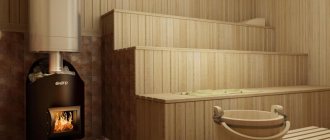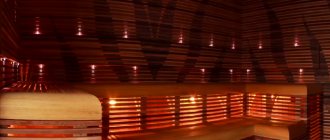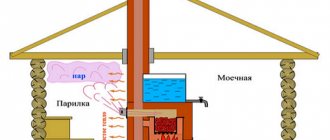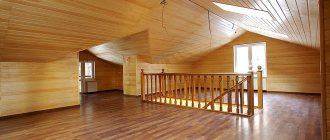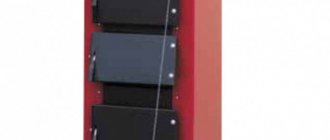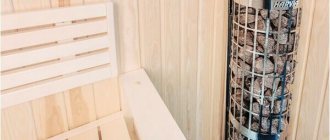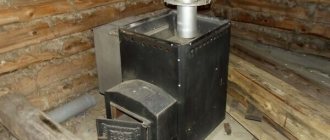Operating principle and design
To make coal stoves, I use brick or metal (cast iron and steel) . Metal devices are more compact, but become very hot during operation; they require the installation of a protective screen.
Brick has the ability to accumulate and gradually release heat, so these furnaces make better use of the high heat output of coal fuel.
for efficient operation of equipment . When burning coal, air enters the combustion chamber from below, and not from above, as when burning wood. Therefore, instead of a bottom, a grate is installed in the furnace chamber. The ash pan located underneath it acts as a blower when the door is open.
The temperature in the furnace firebox can exceed 1100 degrees.
In order to ensure the durability of the masonry, heat-resistant fireclay bricks . In some cases, the chamber is additionally reinforced with thick sheets of refractory steel or a cast iron firebox is made.
Features of furnace combustion after a long period of inactivity
Stoves are usually used seasonally. Before kindling you need:
- Check the external masonry of the stove for cracks and crevices. Carbon monoxide and other combustion products can enter the home through damage.
- Clean the chimney and check its integrity.
- Remove flammable objects from the oven.
- Before starting the fire, clean the ash pan and the walls of the firebox.
It is important to check the condition of the fuel. If the coal is wet and begins to crumble when taken in your hand, buy a new batch. When such coal burns, a specific smell will be released, and the walls of the chimney will quickly become clogged.
It is important to wipe the oven walls with a dry cloth. When the firebox heats up, the dust outside will begin to burn, and a persistent unpleasant odor will appear.
Coal stove diagram for home
The design of a brick coal stove is almost no different from the design of a conventional wood stove.
It consists of, located in a certain sequence: foundation, ash pit, combustion chamber, vault, chimney.
The main difference between a coal stove is a reinforced firebox and an increased volume of the ash pan (when burning coal, a larger amount of ash is produced than when burning wood).
A larger area grate is also required (ideally it replaces the bottom of the firebox).
The coal in the combustion chamber of the furnace burns out from below, so the walls of the compartment are made inclined - this design helps the upper layers of coal to sink as they burn out. The dimensions of the standard device are 110x900cm , the height without a chimney is about a meter.
For the bath
The sauna device is characterized by the presence of a heater - a container for stones. Together with it, the height of the stove will be 1.6 m , length 1.1 m , width 90 cm . The heater is made open and located in the upper part of the stove. Because of this, the chimney is located not above the combustion chamber, but to the side.
More compact metal stoves are often installed in the bathhouse. The dimensions of a standard metal coal stove are 50x80 cm and height 80 cm . It is recommended to make the wall thickness at least 8-10 mm.
Pyrolysis boiler
The main difference between pyrolysis units is that they have two connected stoves: in the first, coal burns and heated gases are generated, and in the second, these gases are completely burned, before leaving the device they cool and have almost no smoke.
Thus, the unburnt portions of the exhaust gases are oxidized and produce additional energy used to heat the thermal fluid. This increases the efficiency of the boiler and ensures that the fuel burns out most efficiently, which extends the burnout time of one stack of raw materials to 24-30 hours, and if there is a bunker, then up to 4-7 days.
Making a device yourself
Carrying out brickwork is quite a difficult job if you lack experience. Therefore, before starting construction, it is better to seek advice from a master. When making a stove yourself, it is important to carefully follow all the steps and not change the selected project design.
Project selection, drawings
The choice of oven model is primarily influenced by the desired power of the device. The efficiency of the heater depends on the size of the combustion chamber. Typically, coal combustion has a heat output of about 500 kcal/hour . Therefore, a device of standard dimensions 110cmx90cm is suitable for heating a room up to 35 square meters. m .
Photo 1. Drawing of a metal coal stove. The device is small in size, it will fit even in small rooms.
Photo 2. Drawing of a coal stove made of metal. Arrows also indicate all parts of the device.
Materials and tools
To build a coal stove, you will need fireclay bricks that can withstand heating up to 1400-1650 degrees without cracking. To prepare masonry mortar, fatty clay is used mixed with water and sand. To lay out the external walls you will need solid red brick.
Doors, hinges, and grate are purchased at a hardware store.
The work will also require tools: hammers, a trowel, usually a mortar shovel, a hacksaw, a grinder, a building level, plumb lines, and a tape measure.
Stages of work
When choosing a place to build a stove, factors such as the location of the chimney and the size of the room (in a large area it is better to install the equipment in the center).
The walls and ceiling in the selected area are sheathed with fire-resistant material.
It is better to immediately think about the place where the coal will be stored - in order to avoid fire hazards, it should not be placed in close proximity to the stove . It is also necessary to take into account that coal is very dusty and dirty.
A massive brick oven is installed only on a concrete foundation , which is not connected to the main one. Therefore, its location is better than
How to build a stove?
First you need to understand what requirements are put forward for a heating stove for coal:
- the heater must warm up evenly and quickly, intensively transferring heat to the air in the rooms;
- the outer walls of the brickwork facing the rooms can warm up to a maximum of 90 °C;
- fuel combustion must be efficient;
- the stove should be located in the house in such a way that its walls heat several rooms;
- when constructing the body of the stove and chimney, it is important to comply with all fire safety rules;
- It is not allowed to use flammable materials during construction;
- the masonry must be smooth, without cracking;
- The heater should be finished in accordance with the interior of the home.
When the requirements are known and worked out in relation to your home, you should select a stove design that is suitable in size and lay a solid foundation for it.
Laying the foundation
Layout diagram of a corner stove.
A coal stove is a massive and quite heavy structure, and therefore the foundation for it must be made reliable. Its dimensions in plan are taken to be 5 cm larger in each direction from the dimensions of the future structure.
An important condition: the foundation of a brick heating or cooking device should not be connected to the base of the building itself, but should be at least 10 cm away from it.
Work on laying the foundation is carried out in the following sequence:
- Dig a hole, the depth of which depends on the location of non-subsidence layers of soil (clay). Compact the bottom of the pit using a hand tamper.
- Pour a layer of crushed stone 10-15 cm thick and compact it too.
- Next, you can fill the pit with rubble stone and water it with liquid mortar, or pour a reinforced concrete slab. The height of the base is made level with the subfloor.
- For waterproofing, 2 sheets of roofing material must be laid on the upper part of the foundation after the concrete has hardened, and for fire insulation - basalt cardboard and roofing steel.
After laying the foundation, you can begin building the stove according to the procedures.
Possible errors and difficulties
In order to avoid miscalculations when building a stove yourself, it is important to carry out the steps exactly according to the diagram.
The most common mistakes you can make are:
- Using unsuitable materials leads to rapid cracking of the seams. Brick also begins to crumble over time when exposed to high temperatures.
- The ash pan is of insufficient volume . The compartment quickly becomes clogged with ash and impairs draft, which can create a risk of carbon monoxide poisoning.
- Incorrect installation of fittings. All metal parts expand when heated, so if you don't leave a small gap, the metal will press against the masonry and cause cracking.
- Improper commissioning causes cracking of masonry joints when heated.
To dry the device, it is allowed to stand for two to three weeks , then they begin to heat it with small portions of fuel, gradually increasing the load. Complete drying of the oven usually takes about a month.
Why might there be smoke?
Even if the stove is heated correctly, plumes of smoke may form and enter the home. More often, this is caused by low quality coal. However, the causes of problems are:
- Clogged chimney or ducts.
- The appearance of cracks and holes in the masonry. The draft and smoke temperature are significantly reduced.
- Destruction of internal masonry or well.
If ignition is carried out in a cold firebox, smoke may appear. Soot will begin to form if several heating devices are connected to the chimney. To prevent carbon monoxide, smoke dampers must be installed.
Features of choosing coal fuel: stone, wood, brown, anthracite
For successful operation of the device, several types of coal are used:
- Stone - has a black color, hard to the touch, and crumbles easily. Its humidity is 11-15%, heat transfer is 5 thousand kcal/kg. It is poured into the firebox in a layer of 12-18 cm , suitable for all types of devices.
- Wood - has a shiny black color with a blue tint, humidity 7-15% , heat transfer 7.5-8.1 thousand kcal/kg.
- Brown - has a light brown color, humidity up to 40% , heat transfer in the region of 3.5-5.5 thousand kcal/kg . Universal, suitable for all types of heaters. Its disadvantage is the presence of harmful impurities.
- Anthracite is the oldest type of coal, humidity 7% , heat transfer up to 9 thousand kcal/kg. Due to the high combustion temperature, it is only suitable for devices with specially reinforced combustion chamber walls. This is the most expensive type of fuel.
During operation, it is better to pre-sieve the coal so that no dust remains in it. Then gaps will form between the pieces, improving air convection, and the burnt dust will not form soot deposits on the walls of the firebox and chimney.
Coal as a fossil fuel
Coal is a type of fossil fuel. The process of its formation occurs from ancient plants deep underground without access to oxygen, for quite a long time. Coal rock is, first of all, carbon containing non-combustible impurities. Coal is generally classified as follows:
- Lignite is the lowest age type of coal, has a brown color, up to 45% moisture content, high sulfur content, and is the most friable compared to other types of coal. Mainly used in power plants.
- Brown coal is also a fairly young type of solid fossil. Carbon content up to 70%, humidity about 40%, volatile substances 38-50%. It is used as local fuel, sometimes as a chemical raw material.
- Coal is a sedimentary rock formed as a result of the decomposition of plant remains. Here the composition is more saturated with carbon (from 75% to 95%) and contains less water (8-20%) and impurities that form ash.
- Anthracite is coal of the most ancient origin, has high density and shine. Carbon content 95%. Solid fuel from such coal does not ignite well, having the highest calorific value.
Principle of operation
The operating principle of a coal stove is not much different from a wood stove. This is a very common misconception. Coal and wood heating stoves differ radically. And here's what:
- For coal to burn, air must come from below.
- Coal requires preheating before being sent to the firebox. Raw coal simply won't burn.
- The chimney should allow air to flow faster than a wood stove. With this design, there is no damper at all. The air supply is regulated from below, through the blower.
The combustion process of coal takes much longer. Coal does not burn quickly like firewood, but smolders over a long period of time. The combustion temperature is higher, which places special demands on the materials for the manufacture of the stove. We'll talk about this later.
Speaking about the process of burning coal, it is worth paying attention to one feature. If firewood during the pyrolysis process easily breaks down into coke and gases, which have a high temperature and heat transfer, then coal burns differently. On the surface it will have the highest temperature, and the temperature of the exiting gases will be much lower.
Preparatory stage of lighting the stove
If you are planning to light a stove that has not been used for a long time, you should carry out a number of preparatory measures. This procedure must be carried out in order to ensure trouble-free operation of the stove, as well as to avoid unpleasant situations that sometimes lead to fires or harm to human health and life.
• Inspect for cracks. Their presence can facilitate the penetration of smoke and even carbon monoxide into the room. If any are found, minor repairs should be immediately carried out using a mixture of clay and sand. • Clean soot from all flues and chimneys. Wipe off dust from the internal walls with a dry rag so as not to smell a bad aroma when kindling. In general, it is advisable to perform this procedure 2-3 times a month.
• Pay attention to the doors, especially their fit and the functionality of the locking mechanisms, to avoid the appearance of smoke. • Select fuel of the appropriate quality, suitable specifically for your type of stove
• Properly equip solid fuel storage areas.
During further operation, you should also follow a number of simple rules. Using plastic, construction and household waste for kindling will lead to severe contamination of the stove. It is incorrect to open the vent and the oven door at the same time. It should be heated several times a day for one and a half to two hours to avoid overheating. Dry, medium-sized, dust-free charcoal will provide excellent functionality.
https://www.youtube.com/watch?v=
Avoid storing flammable objects near hot walls. Do not leave the stove unattended while lighting, especially in homes with children.
Tags: heating, stove, coal
« Previous entry
Device
A DIY coal stove includes the following elements:
- blower;
- firebox;
- chamber for drying fuel;
- chimney.
The design of the firebox and chimney differs from analogs that burn wood. The firebox has two compartments. In one compartment, firewood is lit, in the other, coal is dried. Once the temperature is sufficient, the coal also begins to burn. This is due to the fact that coal has a fairly high combustion temperature and it is simply impossible to light the stove using the standard method.
A combination firebox is often used, which can operate on both wood and coal. This option is the most rational for a coal stove for heating a home.
In which ovens can you burn coal?
Since, as a result of combustion, coal produces a higher temperature than wood fuel, stoves for combustible stone (black gold) are slightly different from wood-burning designs.
Although, you can burn with coal using an ordinary brick oven, but only with thickened walls and a 2-row grate. Plus, such a heating structure must be equipped with an additional hood that would not be connected to other channels.
There are designs with two water boilers in the furnace, with the help of which not only the room is heated, but also the brickwork is significantly cooled. Such devices require special supervision, since they must constantly contain water.
Plus, the dimensions of the grate and ash pan must be identical, otherwise there may be significant heat losses.
It will be interesting! Instructions on how to make a bell-type stove.
Kinds
Coal stoves for heating a home can be characterized by the following indicators:
- By appointment. A coal stove can be used not only for heating, but also perform additional functions. According to this parameter we can distinguish:
- Heating stoves. Coal is an efficient fuel. Such coal stoves, especially those made of brick, are much more powerful than their wood-burning counterparts. They are able to provide heat to the entire house, and not just 1-2 rooms. This oven is large in size and weight. In production, materials with increased strength characteristics and maximum heat resistance are used. Such a heater requires a reliable foundation on a perfectly level base.
- Stoves and fireplaces. A coal stove-fireplace can not only reliably protect a room from the cold, but also performs a decorative function. Such stoves must have an attractive appearance and often become a central design element. The main attention is paid to the correct selection of finishing materials. It must meet several parameters: be environmentally friendly, retain heat well, protect against injury, and have an attractive appearance. Most often, natural stone is used for finishing.
- Ovens with hob. They have an additional cooking surface that allows you to cook food. The container must be thick enough to withstand the high temperature. It is ideal to use cast iron. This cookware will never burn out and food cooked in it has a special taste. This material is also suitable for making a hob, but has a big drawback. Cast iron is very brittle and cracks easily. Therefore, you will have to be extremely careful when using it. Alloy steel is also used for the hob. This material is not afraid of temperature changes and is very durable. It is used more rationally.
- Stoves for household needs. We are talking about a furnace with a heat exchanger. This option will not only save you from the cold, but will also provide you with hot water, which can be used for household needs. You can install a heated floor system. This will allow the room to be heated more evenly.
- According to the type of material used. For a stove that runs on coal, you need to use a material with increased resistance to high temperatures. Experts recommend making a stove from the following materials:
- Brick is the most common material for making stoves. Its advantage lies in its high heat capacity - the material is able to accumulate heat and release it evenly over a long period of time. The disadvantages are also obvious: the large mass of the structure and the complexity of manufacturing. From the point of view of financial costs, it is the most economical option.
- Steel has become a frequently used material recently. The material is quite strong and durable. It is used for the manufacture of factory products. It is better to make a steel coal stove with your own hands. The labor intensity of the work is significantly lower than when making an analogue from brick. The room heats up faster, but there is a significant drawback. A steel stove, unlike a coal-fired brick stove, is not capable of retaining heat. As soon as the fuel runs out, it instantly cools down.
- Cast Iron - Cast iron occupies an intermediate position between steel and brick. The weight of such a furnace should be significantly greater than a steel one. It will heat up and cool down faster than brick. With careful use, this design will last for several decades. Making such a stove yourself is quite problematic. A factory analogue will not be cheap.
- Talkomagnesite. The material has excellent thermal conductivity - ten times higher than that of brick. And this despite the fact that its ability to store heat is only 44% worse. What does this mean in practice? Such a stove will heat up almost as quickly as a metal one, but will produce enough heat to avoid adding fuel during the night. This material is also not without its disadvantages. Such a heating stove will be heavier than a brick stove with the same dimensions and is not cheap.
- Combined. It is impossible to select the ideal material for a heating stove. As you can see above, each material has its pros and cons. What if we take their strengths and combine them with each other? The advantages of one material can successfully offset the weaknesses of another. This technique has been used for quite a long time. A cast iron boiler can be lined with soapstone (another name for the mineral is soapstone or stove stone) and a water heating circuit can be added.
- According to the method of fuel combustion. A distinction is made between stoves with a conventional firebox and devices with a long-term combustion function, which can operate up to 3 times longer on the same amount of fuel.
Homemade potbelly stove
Recently, many designers have been offering exclusive versions of potbelly stoves or fireplace stoves that are installed in country houses. For residents of prestigious cottages, they are not only an additional source of heat, but also a beautiful accessory for the interior design of the room. Such individual stoves fill the room with warmth and special comfort. Firewood crackling in a stove or fireplace looks very beautiful and romantic when a winter blizzard is raging outside the window.
The most popular, primitive and effective long-burning stove for temporary heating is the well-known potbelly stove. Its simple design is based on the “symbiosis” of a Russian stove and fireplace. With one load of fuel, it is capable of maintaining a comfortable indoor temperature for 4 hours. The potbelly stove can be installed in any space where a chimney can be removed.
Homemade unit
Today, anyone who has the skills to perform plumbing work can make a potbelly stove with their own hands from all kinds of available materials. This oven:
- Does not depend on electricity or gas.
- Easy to maintain and operate.
- Allows you to control the combustion process.
- Takes up little space.
- Compact and economical.
- May have a hole for installing utensils to cook food or heat water.
Among the disadvantages of such a furnace, it should be noted the low efficiency, high speed of exhaust gases and rapid cooling. Therefore, to maintain the temperature in the room, it must be heated constantly.
The following can be used as fuel for a potbelly stove:
- coal;
- firewood;
- pressed wood chips;
- sawdust briquettes.
Materials and equipment for independent work
Our craftsmen make potbelly stoves with a welding machine on hand and used:
- large cans;
- metal corners;
- wide pipes;
- gas cylinders;
- metal boxes;
- large fire extinguishers;
- old barrels;
- steel sheets;
- chimney pipes;
- metal gratings.
Procedure
For ease of work, you can also use factory-produced technical fittings in the form of:
- grate;
- gate valve;
- burners;
- cast iron doors.
Main elements of the combustion unit
Detailed drawings are not needed to make a potbelly stove. The main thing is to get the most efficient design possible. Let's look at the main components that make up a homemade stove.
Combustion chamber
It is the combustion chamber that performs the function of heat transfer. The larger the outer surface area, the better.
It is important that the bottom of the chamber has sufficient area to place firewood or coal there. Therefore, cylindrical homemade devices are placed on their sides. Rectangular ovens are designed in a horizontal design with a minimum size of 250x350 mm.
Large stoves made from barrels or gas cylinders are also practical in a vertical position.
Ash pan
Type of finished product
An additional ash pan welded or screwed to the bottom of the structure is convenient for selecting ash. Its arrangement with a blower promotes better heat generation, and the lower door ensures the supply of the required amount of oxygen and regulation of combustion intensity.
Doors and openings
These elements are made with your own hands from the leftover metal after cutting out the openings. After all, the scraps from the cylinders repeat the bend of the surface, and this is very important in work. Steel door canopies are attached to the body by welding, and then the doors themselves are hung on them.
Here it is necessary to provide a locking device, which can be made like a guillotine bolt or bolt.
The optimal openings for the firebox have dimensions of 250x250 mm, for the blower - a height of 100 and a width of 250 mm. Canopies are installed on one vertical axis. A distance of approximately 10 centimeters is maintained between the openings. To prevent coals from falling out of the door, the firebox opening is located slightly above the level of the grate.
Chimney
Attaching the chimney
To remove flue gases in a potbelly stove, use a steel pipe with a diameter of 100–150 mm. The pipe itself is not insulated - it serves as an additional source of heat. And for better heat transfer, it is placed towards the outlet with inclined or horizontal sections, thereby increasing the path of warm gases.
The outlet pipe for connecting the chimney is located on top or, preferably, on the side. The latter option slows down the removal of gases, leaving space for the cooking zone.
Note! It is advisable to use a rotary or guide valve in the chimney to regulate the intensity of the removal of hot gases.
Advantages and disadvantages
The following advantages of coal stoves can be highlighted:
- High power - achieved due to the higher temperature of fuel combustion.
- High efficiency - up to 60% with a conventional firebox (in a brick kiln) and up to 90% in a long-term combustion kiln made of brick.
Disadvantages are also present, but they can be effectively dealt with:
- Coal stains everything around . The problem is solved by installing a firebox in a separate room.
- Formation of dust, soot and soot. You will have to clean the chimney regularly (at least twice a year). Combustion products from the ash pit must be removed before each new firebox. All joints must be hermetically sealed with fireclay clay.
- Coal is demanding on storage conditions . This should be a separate dry room, protected from wind and precipitation. There is no point in storing coal for more than a season. It cakes and you end up with lumps, which are not very pleasant to break out every time.
- High price. This issue varies greatly by region. In some places, coal is rare and its use is not economically feasible. In other places it is the main type of fuel. Compared to wood, the higher price is offset by longer combustion time and greater heat output (fuel savings).
Boiler with automatic feed
An automatic coal boiler is practical to use; the duration of the process is set on it, for a single placement of fuel, from 3 to 30 days, based on the fuel being loaded, the power and capacity of the container.
- These boilers operate on spilling fuel types: fine coal, pellets, wood chips and other elements.
- Please note that different fuels require different burner structures and fuel delivery mechanisms.
- For example, for pellets the burner corresponding to the name is very suitable, and for coal the best option would be a retort burner with special properties.
- When choosing a given boiler, it is important to determine what fuel will be used for it.
There are universal boilers specifically designed for pellets and fine coal. These boilers contain a container where the fuel is located and a mechanism for transferring this fuel to the combustion section.
Devices for transferring fuel raw materials are made of a mechanical type, operating with the help of augers, and pneumatic, operating on the basis of a compressor for pumping air.
Boilers with automatic transmission can come complete with built-in grates directly into the furnace for stacking coal with firewood. The combustion mode is controlled automatically.
These boilers are often equipped with many different unique functions: self-cleaning, control via telephone and other capabilities.
How to choose for a home and selection criteria?
To choose the right oven you need to consider the following:
- The design is factory or made by hand. Below we provide detailed instructions for both options.
- Determined by the type of furnace (see the corresponding section).
- Select the necessary parameters. Let's dwell on this point in more detail. In order for the stove to live up to your expectations, you need to consider the following:
- Choose the right power. With factory appliances, everything is simple - manufacturers indicate in the passport the power and cubic capacity for which the stove is designed. You should try to ensure that the volume that needs to be heated is somewhere in the middle of the specified range. This will ensure the necessary reserve in case of possible heat loss. With a homemade stove, not everything is so simple. You will have to perform the calculation yourself, using the formula:
P = (M-Bridge)*Sp/T/1000, where
P – required power, kW
M - weight of fuel used, kg
BRIDGE - mass of the remainder of the burned fuel (i.e., what remains after the active combustion phase), kg
Cp - thermal conductivity of coal, J/kg
T is the coal burning time. M is determined by the formula: M=a*b*c*Pl*Kz, where
M - weight of fuel used, kg
a, b, c - overall dimensions of the firebox from the inside, m
Pl - coal density, kg/m3
Кз - furnace fill factor (usually taken 0.6-0.7). By substituting the initial data, it is easy to determine the power that the stove will produce. To determine the usable power, multiply it by the efficiency of the furnace.
Now let's determine the required power. For 1 m2 of area you need 0.1 kW of heat. These figures do not take into account possible heat loss, which is different in each room. Therefore, it is recommended to take power with a margin of 10-15%.
- Material of manufacture.
- Volume of loading and automation. Coal loading in modern boilers can be automated to such an extent that fuel will have to be added every few weeks. The rest of the time the oven will operate in autonomous mode.
Guidelines for selection
You can make the right choice using the project, which should include all the design characteristics, methods of connecting communications and other parameters. You can find the necessary information in the instructions for using the device.
Determining main criteria:
- Type of housing material. The material used to produce the housing affects the repairability. Steel is resistant to changes in temperature and pressure, but is susceptible to rust and burnout.
- Cast iron is a long-lasting material on which high furnace power can be used, but it does not tolerate shocks and sudden temperature changes. If there is a small hole, the steel body can be welded, but when a crack appears in the cast iron, the entire assembly will need to be replaced.
- Manufacturers often make steel-clad boilers with a cast-iron stove.
- Single-circuit or double-circuit. With a single circuit, designed only for heating rooms, it is connected to a number of radiators and heats water exclusively for them. Consisting of two circuits, it is used both for heating rooms in the house and for heating water for residential needs and is supplied to heated floors.
- Minimum required power and heated area. The power calculation is used in the proportion of 100 W of heat for the entire m2 of room area.
Efficiency - due to it, you can see the ratio of the volume of fuel raw materials to the mass of output heat produced by the device. For a coal boiler, this figure ranges from 65-92%, depending on the structure, type of combustion and level of automation.
What are the prices for coal boilers? The price for coal devices, depending on the manufacturer, varies from 23,000 to 258,000 rubles.
Best models
Let's look at the best factory-made models, and then move on to making a coal stove with your own hands. These models are suitable even for a large country cottage. You can buy them on the manufacturer’s website by submitting an online application.
| Name and price (RUB) | Characteristics | ||||
| Room area m2 | power, kWt | Dimensions, mm Chimney, mm | Weight, kg | ||
| Zota stakhanov 100, from 370000 | 1000 | 100 | 900x1608x1796, 800 | 880 | |
| Teplov T-100, from 185000 | 1000 | 100 | 1770x810x810, 250 | 900 | |
| Vulkan EKO- 100, from 330000 | 1500 | 100 | 1770x810x810, 250 | 900 | |
| "Bourgeois-K" T-100A-2K, from 272000 | 1000 | 100 | 780x1420x1890, 250 | 900 | |
| Ferroli Forest 100, from 1200000 | 1000 | 115 | 2898x4533x2700, 200 | 1230 | |
Prices: summary table
Price rating of long-burning coal boilers (table):
| Long burning coal boiler model | Cost, rub. |
| Stropuva S15U | 85 400–90 560 |
| Heiztechnik Q Alfa 15 | 62 240–68 720 |
| Buderus Logano S181-15E | 218 000–250 640 |
| WEEK KO-60 | 115 900–130 500 |
| TIS (TIS) PRO 11 | 64 100–67 200 |
| LIEPSNELE L20U | 81 500–99 770 |
| VIADRUS Hercules U22D | 126 600 –128 530 |
| Galmet CARBO 21 | 103 890–116 750 |
Do-it-yourself coal stove for a summer residence
The cheapest way to make a brick heating stove using coal with your own hands.
Materials
We will need:
- brick;
- ready-made mortar mixture for laying stoves;
- cast iron grate;
- cast iron hob;
- metal sheet b=4mm - 600x1200 mm - 0.72 m2;
- electrodes for welding - 1 pack.
Tools
- trowel;
- trowels;
- hammers;
- drill;
- other.
Scheme and order
Description of the masonry
- We lay a brick on top, without mortar (see photo No. 2, first row). We strictly control horizontality using a level.
- We install the door for the blower. We secure it with wire and wrap it with asbestos cord.
- We place grate bars directly above the ash pit.
- We continue laying according to the order (see photo No. 2)
- Installing the firebox door. We secure it with wire and bricks.
- The row at the top should overlap the combustion door and end 130 mm above it.
- We continue laying, moving the bricks back a little. Before this, we lay an asbestos cord on which we will install the hob.
- Let's start forming the chimney from the next row. The design provides for the installation of a mounted pipe made of tin or corrugated aluminum. The pipe should not be heavy. Otherwise, the center of gravity may shift.
- On the eleventh row we install a valve to regulate the air flow. Don’t forget to seal it with asbestos cord and cover it with clay.
- Next, we place a chimney pipe in the quadrangle, which we connect to the metal one. The pipe must stand strictly vertically and not lean to the side. For greater stability, it should be covered with three rows of bricks.
- We remove the knockout bricks that we placed on the 4th row and clean the chimney of debris.
- Now the coal stove for the home should be whitewashed. Any lime will do. Experts recommend adding blue and a little milk. This way the whitewash will not darken and fly off.
- We install a metal sheet in front of the firebox.
- Installing the plinth
Making a charcoal stove with your own hands is not easy. It is better to seek help from an experienced stove maker or be patient.
Simple rules for using the oven
Having carried out the preparatory activities, you can begin kindling. To begin with, on the bottom of the firebox, cleared of ash and soot, we place a kind of pillow of crumpled newspapers and paper, then small dry wood chips. Next, we put small firewood, for example, birch (they burn easier).
Firewood should be stacked in the form of a “well” or “hut”, leaving space between the firewood so that nothing interferes with air circulation. Now you can set it on fire, whether it’s a match or a special spray can, it makes no difference. We close the door. Using a blower we regulate the intensity of combustion. We open it, letting in a sufficient flow of air, without which the flame can simply go out.
When the stove has warmed up using wood, you can add coal. The first layer is usually small 10-15 centimeters. After the first layer flares up, we increase the layer of coal rock to 60 cm (if the size of the furnace allows), using coals of a larger fraction. It should be remembered that clearance is required between the fuel layer and the upper arch of the firebox. All that remains is to ensure that the coal mass does not sinter; to do this, we periodically carry out a poker, ensuring an air flow.
As a rule, coal is loaded through the firebox door. However, if there is a hob, then by moving the elements of a large burner, we get a more convenient way of bookmarking.
The rules are simple, but there are many benefits. Following them will ensure the safe operation of your oven. The warmth and comfort of your home is in your hands.
Conclusion
Whether to choose a ready-made option (which is simpler, but more expensive) or to opt for making a stove with your own hands is something everyone decides for themselves. According to the main criteria, a coal stove for heating a house is similar to one working with wood.
The main feature is a higher combustion temperature of the fuel, and, accordingly, higher efficiency. Coal is more expensive than firewood, but this difference is offset by greater heat transfer. This oven is thick.
pechnoy.guru
Compliance with safety conditions during operation
When planning to make a long-burning stove with your own hands, you must always remember safety precautions. A homemade device should not noticeably reduce the amount of oxygen and release dangerous gases into the interior of the room.
There should be no curtains, curtains, plastic or flammable objects near long-burning stoves. To prevent a possible fire, it is necessary to provide free space near the stove, and below it there should be a metal sheet, brick flooring or foundation.
The nuances of firing stoves in winter
If the temperature outside is low, problems with kindling may occur. A draft is formed that prevents the circulation of combustion products. Therefore, it is difficult to quickly light the stove. To melt, try heating the firebox with an electric hair dryer. The stove will start working better due to the temperature difference.
Coal heating has not lost its relevance. The use of coal stoves is often seen in the private sector, requiring knowledge of many aspects that need to be taken into account in the process. If they are followed, stable heat from the stove and a normal microclimate in the house will be ensured.
Average score of ratings is more than 0
Share link
Comments There are no comments yet, but you could be the first...
